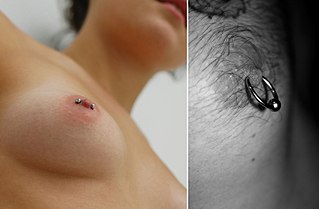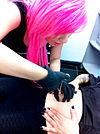
The Prince Albert (PA) is a penis piercing which extends from the urethra to the underside of the glans. It is one of the most common male genital piercings. The related reverse Prince Albert piercing enters through the urethra and exits through a hole pierced in the top of the glans.

A tattoo is a form of body modification made by inserting tattoo ink, dyes, and/or pigments, either indelible or temporary, into the dermis layer of the skin to form a design. Tattoo artists create these designs using several tattooing processes and techniques, including hand-tapped traditional tattoos and modern tattoo machines. The history of tattooing goes back to Neolithic times, practiced across the globe by many cultures, and the symbolism and impact of tattoos varies in different places and cultures.

Genital modifications are forms of body modifications applied to the human sexual organs, such as piercings, circumcision, or labiaplasty. The term genital mutilation is generally used for genital modifications that diminish the recipient's quality of life and result in adverse health outcomes, whether physical or mental.

Mortification of the flesh is an act by which an individual or group seeks to mortify or deaden their sinful nature, as a part of the process of sanctification.

Scarification involves scratching, etching, burning/branding, or superficially cutting designs, pictures, or words into the skin as a permanent body modification or body art. The body modification can take roughly 6–12 months to heal. In the process of body scarification, scars are purposely formed by cutting or branding the skin by various methods. Scarification is sometimes called cicatrization.

An adornment is generally an accessory or ornament worn to enhance the beauty or status of the wearer. They are often worn to embellish, enhance, or distinguish the wearer, and to define cultural, social, or religious status within a specific community. When worn to show economic status, the items are often either rare or prohibitively expensive to others. Adornments are usually colourful, and worn to attract attention.

In female humans and other mammals, the clitoral hood is a fold of skin that surrounds and protects the glans of the clitoris; it also covers the external clitoral shaft, develops as part of the labia minora and is homologous with the foreskin in the male reproductive system. The clitoral hood is composed of mucocutaneous tissues; these tissues are between the mucous membrane and the skin, and they may have immunological importance because they may be a point of entry of mucosal vaccines.

Human physical appearance is the outward phenotype or look of human beings.

Mutilation or maiming is severe damage to the body that has a subsequent utterly ruinous effect on an individual's quality of life.

Play piercing, needle play, or recreational acupuncture is body piercing done for the purpose of enjoying the experience rather than producing a permanent body decoration. Needles, sharpened bones, or other tools used in play piercing are removed from the body when the episode is complete, allowing the wounds to heal. Those who engage in play piercing may do so for self-expression, imitating tribal rituals, spiritual self-discovery, sexual pleasure, or entertainment.

Genital piercing is a form of body piercing that involves piercing a part of the genitalia, thus creating a suitable place for wearing different types of jewellery. Nevertheless, the term may also be used pars pro toto to indicate all body piercings in the area of the anus, perineum, penis, scrotum, and vulva, including piercings such as anal, guiche, and pubic that do not involve perforation of genitalia. Genital piercings can be done regardless of sex, with various forms of piercings available. The main motive is beautification and individualization; in addition, some piercings enhance sexual pleasure by increasing stimulation. Pre-modern genital piercings is most culturally widespread in Southeast Asia, where it has been part of traditional practice since ancient times. Records of genital piercing are found in the Kama Sutra.

Genital tattooing is the practice of placing permanent marks under the skin of the genitals in the form of tattoos.

Modern primitives or urban primitives are people in developed, or modern nations who engage in body modification rituals and practices inspired by the ceremonies, rites of passage, or bodily ornamentation in what they consider traditional cultures. These practices may include body piercing, tattooing, play piercing, flesh hook suspension, corset training, scarification, branding, and cutting. The stated motivation for engaging in these varied practices may be personal growth, personal rites of passage, rejection of society, as a way to connect with antiquity, or spiritual and sexual curiosity.

A nipple piercing is a type of body piercing, centered usually at the base of the nipple. It can be pierced at any angle but is usually done horizontally or, less often, vertically. It is also possible to place multiple piercings on top of one another.
Maya society concerns the social organization of the Pre-Hispanic Maya, its political structures, and social classes. The Maya people were indigenous to Mexico and Central America and the most dominant people groups of Central America up until the 6th century.

Modern Primitives, written by V. Vale and Andrea Juno, is a RE/Search publications book about body modification, published in 1989. The book consists of a collection of twenty two interviews and two essays with individuals and key figures involved the field of body modification in the late 1980s. It was one of the first documents to attempt to comprehensively cover the re-emergence and increasing popularity of tattooing, piercing, scarification, corsetry, sideshow, ritual and other practices in contemporary western society.
Labia stretching, also referred to as labia elongation or labia pulling, is the act of lengthening the labia minora through manual manipulation (pulling) or physical equipment. It is a familial cultural practice in parts of Eastern and Southern Africa, and a body modification practice elsewhere. It is performed for sexual enhancement for the benefit of both partners, aesthetics, symmetry and gratification.

Body piercing, which is a form of body modification, is the practice of puncturing or cutting a part of the human body, creating an opening in which jewelry may be worn, or where an implant could be inserted. The word piercing can refer to the act or practice of body piercing, or to an opening in the body created by this act or practice. It can also, by metonymy, refer to the resulting decoration, or to the decorative jewelry used. Piercing implants alter the body and/or skin profile and appearance. Although the history of body piercing is obscured by popular misinformation and by a lack of scholarly reference, ample evidence exists to document that it has been practiced in various forms by multiple sexes since ancient times throughout the world. Body piercing can be performed on people of all ages, although most minors are only permitted to have earlobe piercings.
Tattoos hold rich historical and cultural significance as permanent markings on the body, conveying personal, social, and spiritual meanings. However, religious interpretations of tattooing vary widely, from acceptance and endorsement to strict prohibitions associating it with the desecration of the sacred body.

















